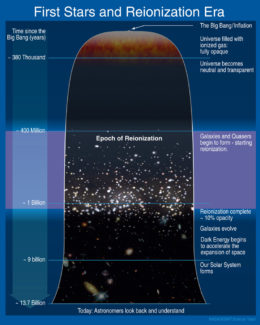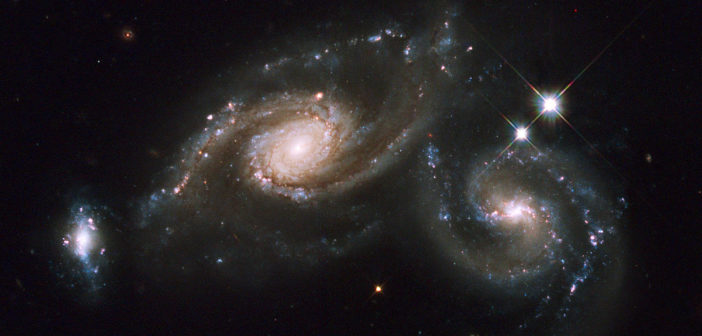In the spirit of Valentine’s Day, today we’ll be exploring apparent pairs of galaxies in the distant, early universe. How can we tell whether these duos are actually paired galaxies, as opposed to disguised singles?
Real Pair, or Trick of the Light?

In the schematic timeline of the universe, the epoch of reionization is when the first galaxies and quasars began to form and evolve. [NASA]
A merging pair of galaxies at high redshift appears to us as a pair of unresolved blobs that lie close to each other in the sky. But spotting such a set of objects doesn’t necessarily mean we’re looking at a merger! There are three possible scenarios to explain an observed apparent duo:
- It’s a pair of galaxies in a stage of merger.
- It’s a projection coincidence; the two galaxies aren’t truly near each other.
- It’s a single galaxy being gravitationally lensed by a foreground object. This strong lensing produces the appearance of multiple galaxies.

Hubble photometry of one of the three galaxy groups identified at z ~ 8, with the galaxies in the image labeled with their corresponding approximate photometric redshifts. [Adapted from Chaikin et al. 2018]
Hunting for Distant Duos
In a recent study led by Evgenii Chaikin (Peter the Great St. Petersburg Polytechnic University, Russia), a team of scientists has explored the Hubble Ultra Deep Field in search of high-redshift galaxies merging during the epoch of reionization, when the first galaxies formed and evolved.
Using an approach called the “dropout technique”, which leverages the visibility of the galaxies in different wavelength filters, Chaikin and collaborators obtain approximate redshifts for an initial sample of 7,000 objects. They find that roughly 50 have a redshift of z ~ 7, and 22 have a redshift of z ~ 8. None of the galaxies at z ~ 7 are in pairs, but the sample at z ~ 8 includes three groups for which the distance between galaxies is less than ~1 arcsecond.
But are these three pairs actual merging galaxies?
Conclusions from Statistics

Top: Gas density at z ~ 7.7 in the authors’ simulation output. Bottom: Mock observations of this output with Hubble’s WFC3 (left) and JWST’s NIRCam (right). [Adapted from Chaikin et al. 2018]
Based on their simulation statistics, Chaikin and collaborators argue that the three pairs at z ~ 8 do represent an unusually high merger fraction — but projection coincidences or lensing are far less likely scenarios to account for all three pairs. If the three pairs are indeed all merging galaxies, it could indicate that this Hubble field corresponds to a local overdensity at a redshift of z ~ 8.
Looking Ahead
The best way to improve on these measurements is to repeat this study with more advanced telescopes. Chaikin and collaborators demonstrate the superiority of the observations that the upcoming James Webb Space Telescope (JWST) will provide. They also point out the potential power of the Wide Field Infrared Survey Telescope (WFIRST) — currently under threat under the proposed 2019 federal budget — to extend the observational horizon well into the epoch of reionization.
Continued studies backed by the power of these future telescopes are sure to discover a wealth of additional distant galactic duos, helping us to characterize the universe in its early stages.
Citation
Evgenii A. Chaikin et al 2018 ApJ 853 81. doi:10.3847/1538-4357/aaa196

4 Comments
Pingback: Parejas galácticas en el Universo temprano – Observatori Astronòmic
Pingback: Parejas galácticas en el Universo temprano « SEDA / LIADA - RedLIADA - Cursos LIADA - Cielo del Mes - Fenómenos Astronómicos - RELEA
Pingback: Parejas de galaxias en el universo temprano « Sección de Astrofísica
Pingback: Febrero 2018 – Observatori Astronòmic